These days SSJ-NEW is preparing for its first flight. At the same time, I often hear the opinion that the Russian aviation industry has hopelessly lagged behind the West, we cannot create anything new, and import substitution is an attempt to resume production of old Soviet aircraft. To say that this is an amateur opinion is to put it very mildly. Yes, today we are not producing civilian aircraft in large series yet. The situation with total sanctions and the need to replace foreign cars with domestic aircraft caught us just at the moment when the ten-year cycle of creating these new aircraft, developing and mastering new technologies and re-equipping production facilities ended.
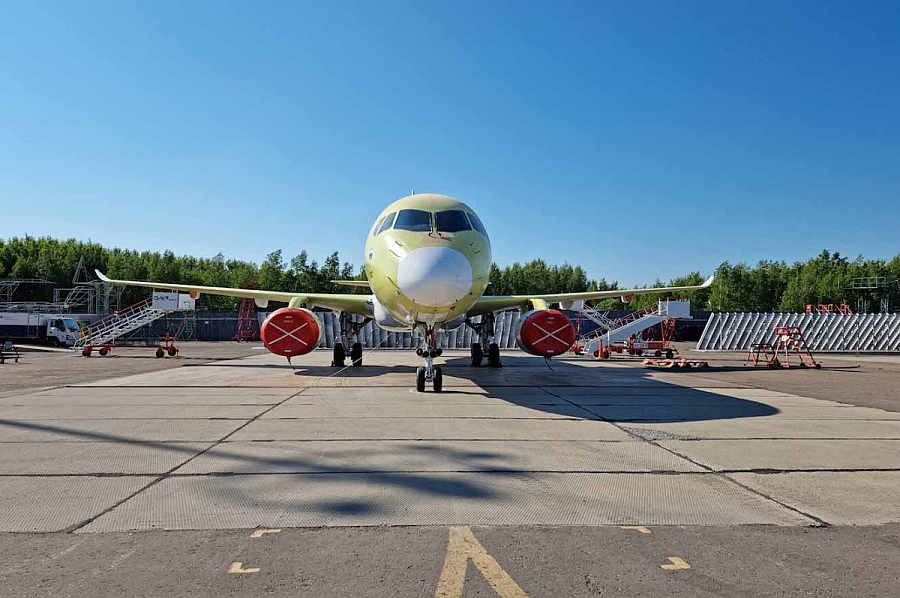
Irkut Corporation has transferred the first SSJ-NEW to the flight test station
Today we are one step away from launching two fully domestic SSJ-NEW and MC-21 aircraft, which are absolutely competitive and in no way inferior to the most modern foreign airliners. And, in my opinion, the most important thing on this difficult path is that, despite the devastation of the nineties, we managed to preserve Russian aviation science and even multiply our scientific reserve for the future.
Experts know that the permission for the first flight of any aircraft is given by the Central Aerohydrodynamic Institute. And it gives for a reason. This is preceded by a set of strength and aerodynamic tests. But it's like I started from the end. After all, even at the stage of development of the device, wind tunnels of their reduced copies are purged here, mathematical models are built, recommendations for improving aerodynamics are given. By the way, it is not for nothing that the Russian school of aerodynamics is considered the best in the world. But I will tell you about this a little later. In the meantime, let's take a look at the TsAGI resource testing hall, where SSJ-NEW and MC-21 are now being "broken".
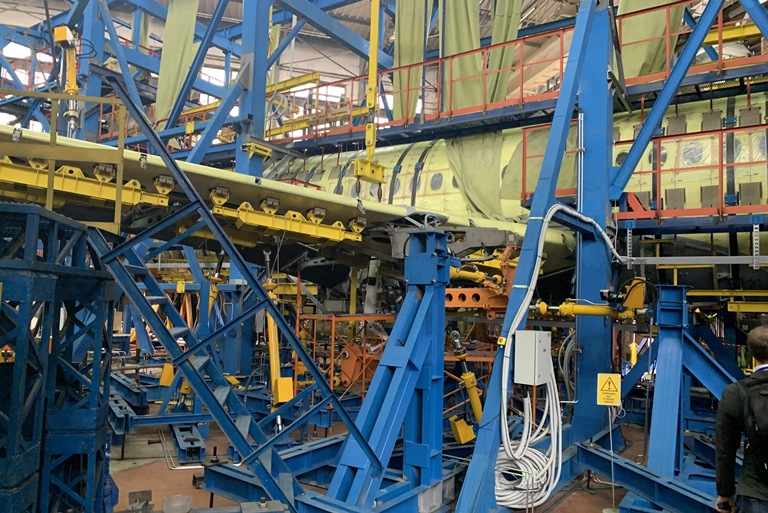
SSJ-NEW aircraft Strength Test stand
Laboratory tests of full-scale aircraft structures are carried out here. This is done in order to work out a full cycle of loads in a laboratory on the ground, a full cycle of all situations that the aircraft experiences during its service life. On these stands, the aircraft experiences and experiences a full range of loads. These are the fuselage load, the wing load, various bending and torsional loads, as well as loads on the tail and landing gear. These loads are applied in different combinations and in different phases to reflect as fully as possible how the aircraft is loaded in the air on the one hand, and on the other hand to avoid its premature destruction.
 "Behind my back is the SSJ-NEW aircraft resource testing stand," says Stanislav Dubinsky, head of the TSAGI Aircraft Design Resource Department, "a number of new Russian technologies have been implemented in this aircraft. These are domestic chassis, domestic fasteners, domestic glasses, domestic composites and other various solutions that we plan to test at this stand. And the second object that is in front of me is the fuselage compartment with the wing of the MC-21 aircraft. The wing is made of Russian composite and these tests have been going on for about a year. A certain amount of experience has been achieved here, which has already allowed this aircraft to be certified in an import-substituted (in part of the wing) version and, accordingly, to receive a certain initial resource."
"Behind my back is the SSJ-NEW aircraft resource testing stand," says Stanislav Dubinsky, head of the TSAGI Aircraft Design Resource Department, "a number of new Russian technologies have been implemented in this aircraft. These are domestic chassis, domestic fasteners, domestic glasses, domestic composites and other various solutions that we plan to test at this stand. And the second object that is in front of me is the fuselage compartment with the wing of the MC-21 aircraft. The wing is made of Russian composite and these tests have been going on for about a year. A certain amount of experience has been achieved here, which has already allowed this aircraft to be certified in an import-substituted (in part of the wing) version and, accordingly, to receive a certain initial resource."
When creating a stand for a new Superjet, the institute experienced considerable difficulties with its equipment with high-tech equipment, due to the sanctions that suddenly fell on the country. For example, all loaders (yellow cylinders in the photo) are quite complex objects, each of which is actually a whole computer. "Because of the sanctions, we had to change the supplier. To finish something ourselves. Because of this, we almost pushed the deadlines. But we found an opportunity to overcome all this and, we can say, assembled an import-substituted version of the loading system," says Stanislav Dubinsky. Now, basically, it's all domestic equipment.
Resource tests take place in several stages. The first stage is carried out in order for the aircraft to receive an initial resource. The initially assigned resource is when the aircraft is issued a type certificate and it gets into service. These tests take place, as a rule, relatively quickly - a year, two, maximum. Then the plane begins to fly, carry passengers and develop this initial resource. And at this time, tests are continuing here in order to increase the assigned resource.
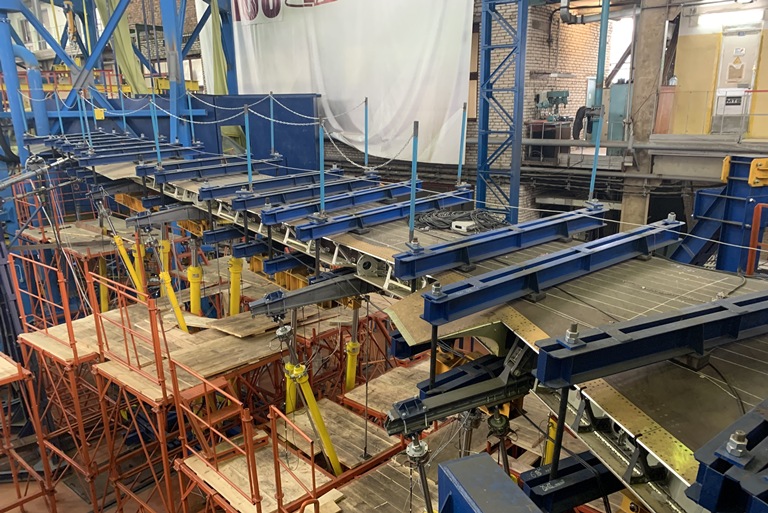
Strength tests of the domestic composite wing of the MC-21 aircraft
The resource of all aircraft in the sky with passengers is always justified by strength tests with a large margin, including, if we talk about a full test cycle. For example, the MC-21 aircraft has a design life of 60 thousand flights. But the volume of tests that is planned to confirm this resource is 240 thousand flights – with a four-fold margin. And the duration of such tests can be a dozen or more years.
It should be noted that the resource is set in three indicators: flights, flight hours, calendar. The conclusion on the initial resource is always issued in these three indicators - which will come earlier, like a car. Strength tests are carried out at TsAGI, which are divided into several categories. There are tests for static strength - this is when a large number of calculated cases are applied to the maximum load. The maximum loads that the aircraft experiences in flight, bending up, bending down, landing, etc. The second category is fatigue tests, but they are not for maximum load, but for repetitive loads, which, in turn, include fatigue mechanisms. There are also tests for rigidity and for flutter. This is already a question of aeroelasticity. Three laboratories are engaged in these tasks at TsAGI: the resource testing laboratory, the static testing laboratory and the aeroelasticity laboratory.
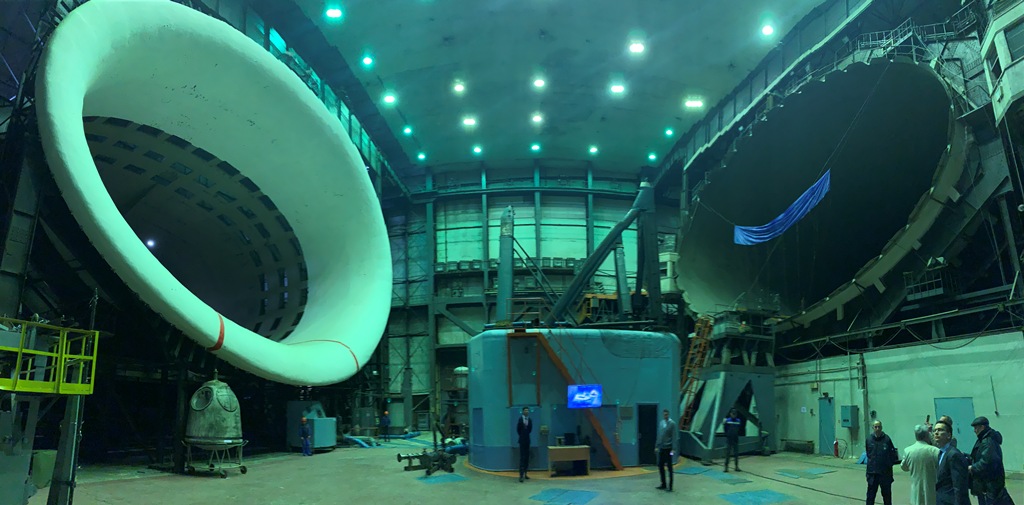
Wind tunnel T-101
The next object, which is simply impossible to pass by, is the unique wind tunnels of TsAGI. As I have already mentioned, this institute is, in fact, older than our civil aviation and was established in 1918 on the basis of the laboratory of Nikolay Zhukovsky. Since 1924, construction of a complex of buildings and laboratories began in Moscow on Radio Street, and in 1934 a site was chosen for a new test base in Zhukovsky (Stakhanovo village). The place was chosen based on several considerations: cars and railways, an area for the placement of an experimental base, an airfield and a hydrodrome (the Pekhorka – Bykovka River), for testing aircraft. It should be noted that in those years the Gromov Flight Research Institute was part of TsAGI.
So the Zhukovsky history of the Institute began from this place, where in 1939 the unique wind tunnels T-101 (airplane tube) and T-104 (for testing full-size working engines) were built. At that time, the T-101 was the largest pipe in the world, and even today it remains the largest pipe in Europe, second only to the American one built in the 80s. This tube is designed to test full-size aircraft, and with running engines. Until the mid-60s, only full-scale objects were tested here, but with the increase in the size of aircraft, they began to test mainly their reduced layouts. However, even today, if the scale of the aircraft allows, a full-scale object is being tested.

A modern young man will probably be surprised that such unique facilities were designed and built without any participation of foreign specialists, our domestic engineers and workers. And there were no zones, no camps, only initiates - the object was secret. And what is even more surprising - these wind tunnels work without a single repair after almost 100 years. The uniqueness of these structures is also emphasized by the fact that during the Great Patriotic War, Luftwaffe pilots were forbidden to bomb the territory of TsAGI, even though the institute continued to work for the Soviet defense industry and long-range bomber aircraft were based here. Hitler really wanted to get himself this valuable trophy unharmed.
Since then, everything that flies has passed through the wind tunnels of TsAGI. Models of our modern combat and civil aircraft, including SSJ-100 and MC-21, were also blown here. Not only aircraft were tested here, but also objects of industrial aerodynamics. Of such objects, we can mention the statues of the Motherland in Volgograd on Mamayev Kurgan and the Worker and Collective Farmer in Moscow, the monument on Poklonnaya Hill and the Zhivopisny Bridge.
.jpg)
"Thanks to this, we managed to make our aviation what it has become. It is not only a monument of history, but also a monument to our ancestors. Because to create unique aerodynamic installations in 3 years, fully work them out, debug the experiment, debug the technology, develop a methodology for conducting the experiment and use it with 100% efficiency, it deserves only respect and admiration," says Mikhail Ivankin, deputy head of the Department of aerodynamics of power plants of TsAGI.
Life goes on. Today, along with field tests, numerical methods are also being widely implemented. Specialists of the Institute are developing special software for calculating the aerodynamics of aircraft, power plants and other equipment. These new technologies are used not only for conducting autonomous numerical experiments of various objects, but also for accompanying tests in wind tunnels.
 "We are one of the world's first developers of a technology called an electronic wind tunnel. When we conduct tests in the pipe, unfortunately, they are not always informative enough. Air, like all aerodynamics, they are not visually visible. For example, we do not see all the features of the aerodynamics of the airframe wing flow and can only determine some specific point parameters, such as pressure distribution, temperature. Then we recalculate the speed. But in general, it is difficult to imagine the overall picture. And parallel numerical modeling allows us to decipher in detail what we get in wind tunnels. How the wing and fuselage flow around, especially in critical modes. For example, we are most concerned about the so-called disruptive regimes. The most dangerous for pilots and passengers. How to see these disruptive modes, just allows you to determine not only the pipe, but also numerical modeling. Therefore, we use two technologies: the first (old) is to conduct a typical aerodynamic experiment. The second is parallel computer computing. This makes it possible to present a more general and understandable picture: what is happening and whether there are any critical moments. It becomes clear: what to treat and how. This is how we get all the necessary information that is needed by both researchers and specific developers of aviation equipment," says Alexander Chevagin, head of the Department of aerodynamics of power plants, deputy head of the Center for Aerohydrodynamics.
"We are one of the world's first developers of a technology called an electronic wind tunnel. When we conduct tests in the pipe, unfortunately, they are not always informative enough. Air, like all aerodynamics, they are not visually visible. For example, we do not see all the features of the aerodynamics of the airframe wing flow and can only determine some specific point parameters, such as pressure distribution, temperature. Then we recalculate the speed. But in general, it is difficult to imagine the overall picture. And parallel numerical modeling allows us to decipher in detail what we get in wind tunnels. How the wing and fuselage flow around, especially in critical modes. For example, we are most concerned about the so-called disruptive regimes. The most dangerous for pilots and passengers. How to see these disruptive modes, just allows you to determine not only the pipe, but also numerical modeling. Therefore, we use two technologies: the first (old) is to conduct a typical aerodynamic experiment. The second is parallel computer computing. This makes it possible to present a more general and understandable picture: what is happening and whether there are any critical moments. It becomes clear: what to treat and how. This is how we get all the necessary information that is needed by both researchers and specific developers of aviation equipment," says Alexander Chevagin, head of the Department of aerodynamics of power plants, deputy head of the Center for Aerohydrodynamics.
Numerical methods allow us to calculate and offer developers the optimal layout of the aircraft of the future. So today, TsAGI is working on a new passenger supersonic aircraft, the demonstrator of which can take to the sky already this decade. It will be a smaller model, about the size of a business plane, and it will go to supersonic. The research has almost been completed and the construction phase of the demonstrator is now beginning.
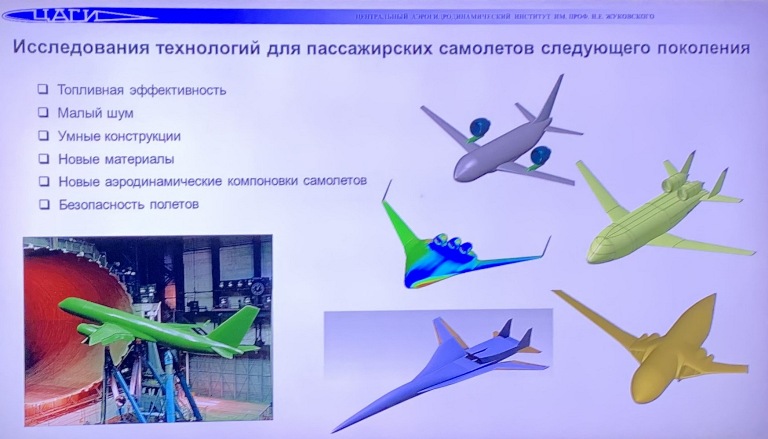
At this stage, two projects are being considered - two dimensions of the future liner. One - around 30 passengers, the second - more than the Tu-144. Time will tell what the final choice will be. The aircraft will have a fundamentally different layout with engines on top, which will reduce the sonic boom. This is one of the most difficult moments.
Another division that is now directly involved in the SSJ-NEW and MC-21 projects is the fifteenth department of TsAGI. His specialization is problems of flight dynamics and aircraft control systems. Moreover, the planes are very different: mainline, transport, combat and even drones.
 "If we talk about TsAGI, there are 4 main directions here – these are strength, power plants, aerodynamics and dynamics of flight and control systems. I represent the fourth direction. Strength engineers are engaged in making airplanes stronger, lighter, and more durable. Power plant specialists ensure the rational integration of the engine and the aircraft. Aerodynamics calculate and measure the forces and moments acting on the aircraft. And our department is engaged in the rational application of these aerodynamic forces and moments. Our goal is to ensure the stability of the aircraft, controllability in the best aerobatic characteristics," says Sergey Bazhenov, Head of the Flight Dynamics and Control Systems Department at TsAGI.
"If we talk about TsAGI, there are 4 main directions here – these are strength, power plants, aerodynamics and dynamics of flight and control systems. I represent the fourth direction. Strength engineers are engaged in making airplanes stronger, lighter, and more durable. Power plant specialists ensure the rational integration of the engine and the aircraft. Aerodynamics calculate and measure the forces and moments acting on the aircraft. And our department is engaged in the rational application of these aerodynamic forces and moments. Our goal is to ensure the stability of the aircraft, controllability in the best aerobatic characteristics," says Sergey Bazhenov, Head of the Flight Dynamics and Control Systems Department at TsAGI.
Flight dynamics and control system are not only experimental science, but also the science that works with living people. Aerobatic characteristics – controllability, stability are primarily needed by the pilot. And if in other directions it is possible to do a lot with computer modeling, then the crew cannot be programmed in any way. Therefore, means of working with pilots are needed here. And these means are aerobatic stands.
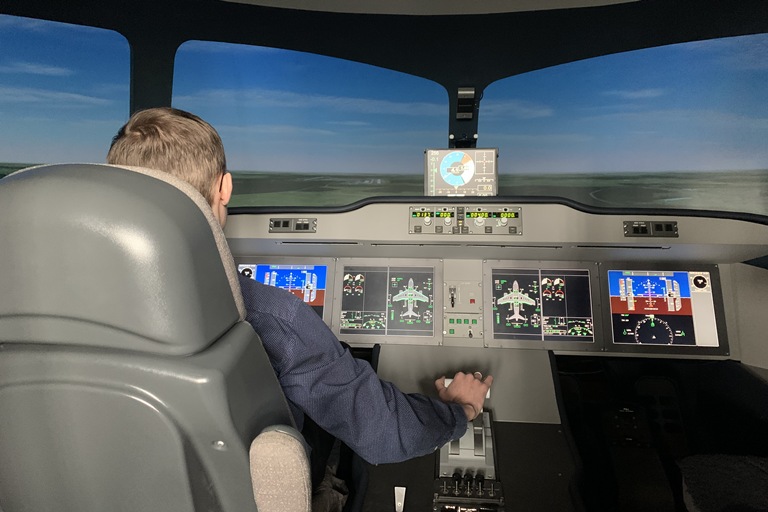
We are at the MC-21 aerobatic stand, which was specially created to test the flight dynamics and control systems of the aircraft. The work here is being carried out jointly with the developer of the aircraft – Irkut Corporation. The development of control laws is the choice of parameters, control levers to ensure the best flight characteristics, as well as the development of human-machine interface tools. Also, pilots were trained here before the first flights of Superjet and MC-21 aircraft, as well as training before the most crucial stages of flight tests: flights at a high angle of attack, at high speed, etc. Real aircraft calculators are installed on the stand, which allows you to check the correctness of the implementation of the control laws and work them out with the crew so that the pilot does not have unpleasant surprises in a real flight.
This is a lot of work. From the first version of the control laws to the one that went on board the aircraft, at least 20 versions were worked out. On the one hand, digital systems have simplified the solution of many piloting tasks, on the other hand, the complexity of control systems has increased dramatically. If earlier there was a direct connection from the steering wheel to the steering wheel, then a modern airplane is a flying computer that allows you to implement many functions. For example, ensuring the specified stability characteristics of controllability, and limiting flight modes. So, a modern aircraft cannot reach an overload that will break it, or an angle of attack from which it falls into a stall or into a tailspin. A large number of comfortable control functions are implemented here – auto-balancing and parrying unfavorable moments.
So, with very large strokes, we just touched the tip of the iceberg of all that colossal amount of work and scientific research that accompanies the long journey of the aircraft from the first sketch drawings to the first flight, and then throughout its life. Moreover, this work begins long before the appearance of these sketches. Science always works ahead of schedule and what is being worked out within these walls today will be used by designers in future decades. And if you look even more closely, it all starts many decades earlier - with training. Many scientists who work in aviation science today studied at Soviet schools and graduated from Soviet institutes. So we came to the idea with which I started this review. The school of aircraft construction has been growing for decades. And, fortunately, during the difficult years for the country, we managed to preserve it. That is why today Russia is part of the elite world club of great aviation powers and in the coming years it is ready to confirm this with a new generation of airliners.











